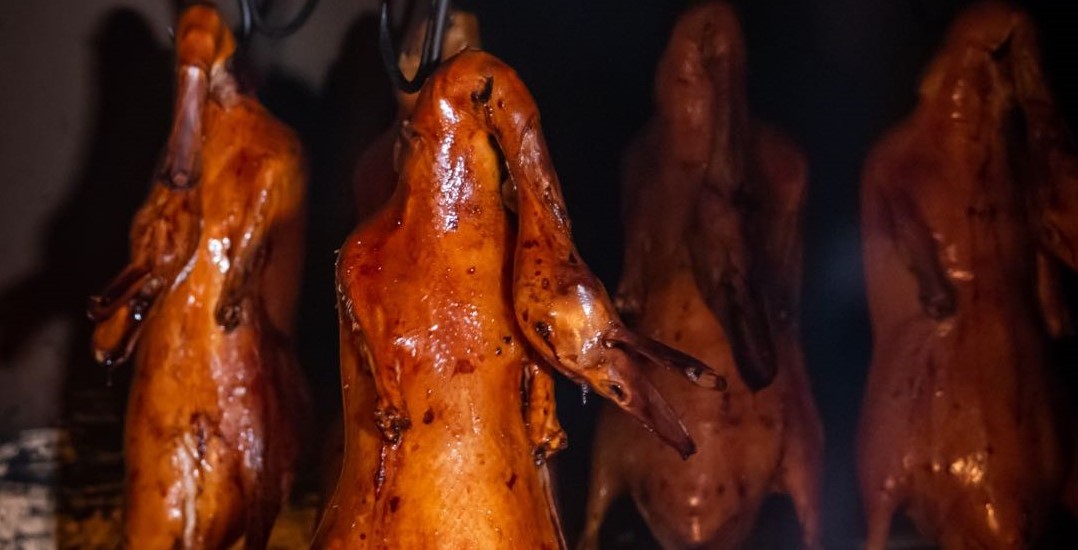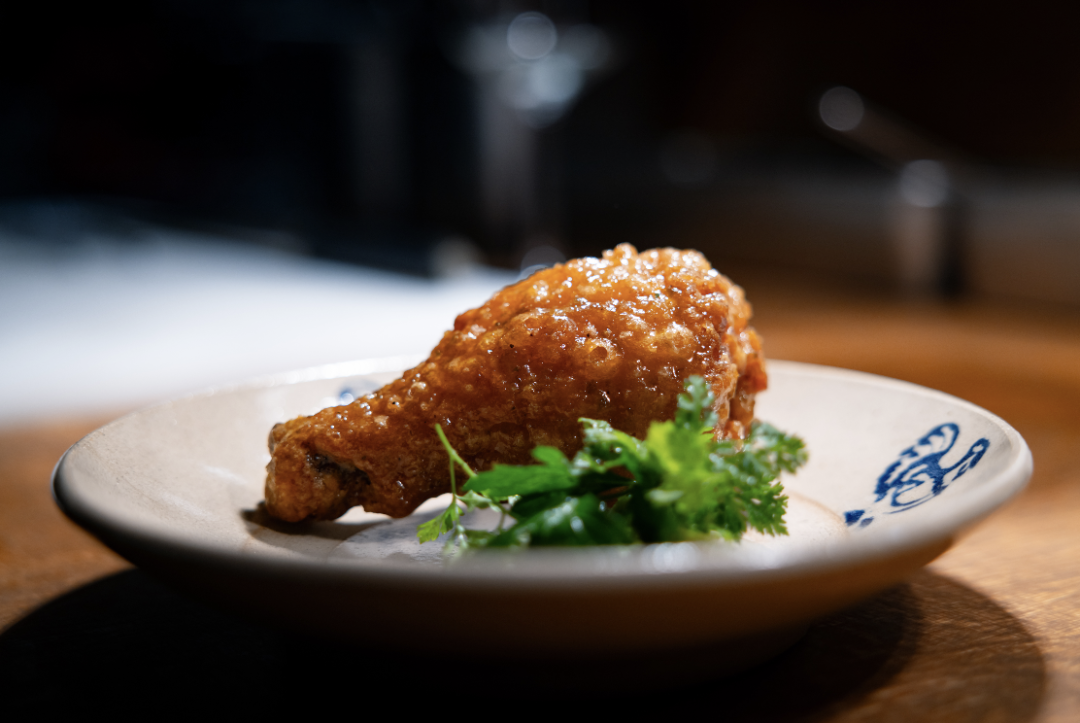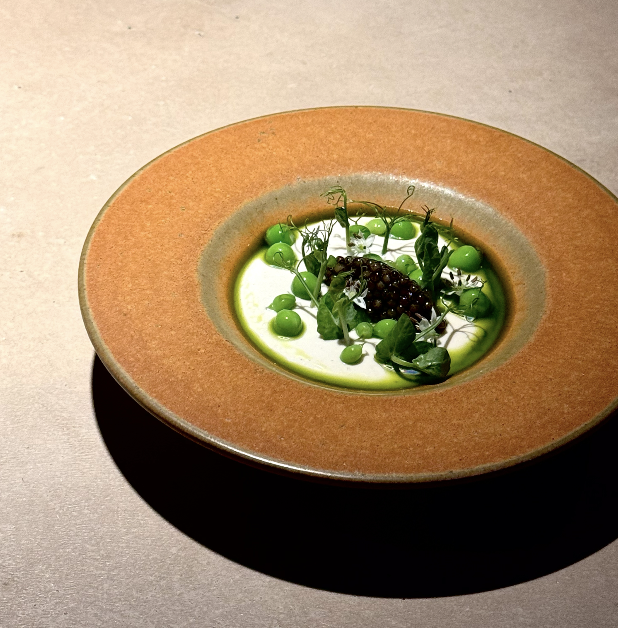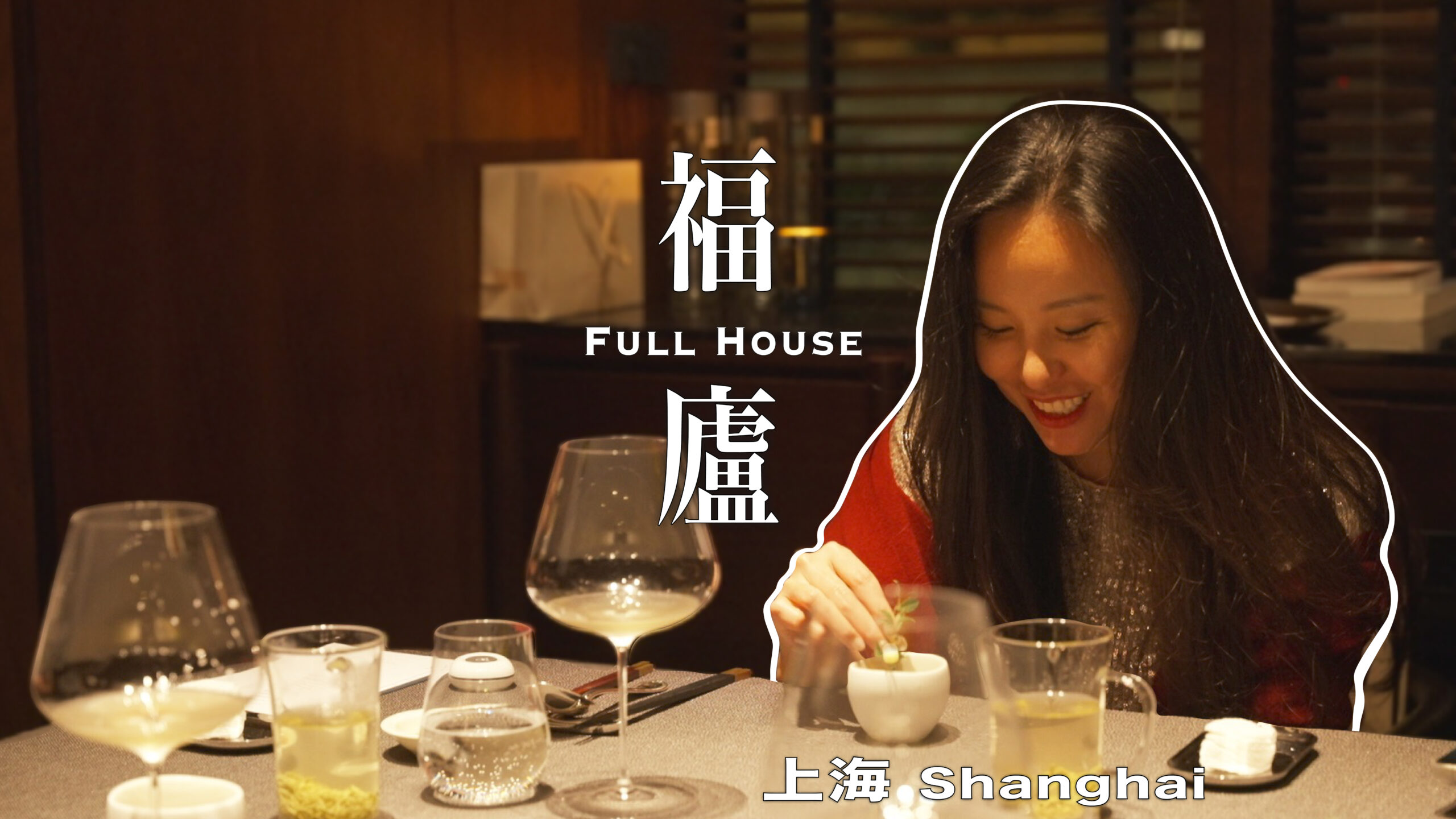After picking up a Michelin star, the famous Peking duck restaurant Sheng Yong Xing has landed a new spot at No.5 on the Bund in Shanghai. Quite unexpectedly, Sheng Yong Xing has become my best pick among all first-time restaurants I visited in Shanghai last year. I could do almost once a week, and sometimes had to book tables for friends every day.
The owner, Wang He, has a wonderful philosophical style in pursuing all the knowledge about ingredients and gastronomy. Degage and confident, he knew too well that his mission to open the restaurant in Shanghai was not just about selling Peking duck, but to bring Beijing and Shandong cuisines to the next level.
The first time I stepped into Sheng Yong Xing, the restaurant’s stunning, exotic décor instantly put me to a foreign land. I couldn’t tell which but maybe Copenhagen? I was completely hooked up. Scandinavian furniture is comfortably housed within bright and spacious dining room. The restaurant is designed with global vision and a complete subversion of a typical Chinese restaurant.
I wouldn’t think No.5 was ideal for Sheng Yong Xing. This I’m not going to exaggerate – a duck saves the whole building. If it not for Sheng Yong Xing, I wouldn’t know when on earth I will actually visit No.5 and I had certainly forgotten that the view from No.5 is just as good as from any other buildings on the Bund.
The restaurant marks a span of some 400 square metres together with its Scandinavian décor. I was pleasantly surprised by the playlist, featuring some favourites from the late Canada’s melancholy bard, Leonard Cohen, whose gritty, baritone voice sets the mood for a drink. This is a bold challenge for a Chinese restaurant, but Wang He didn’t make a big deal of it as for him, good dining ambience stays true to what the restaurant wants its customers to experience, and that’s the way it’s supposed to be.
Wang He told me that the restaurant’s design is all about the view of the Bund, with rest of the décor being reduced to a minimalist aesthetic. When it comes to opening a restaurant in Shanghai, it’s always a pleasure to have it on the Bund. Wang is such a modest and unpretentious gentleman, who knows the ins and outs of music and wine. I’ve always enjoyed conversations with him. 、
Having opened in Shanghai last autumn, Sheng Yong Xing has been a most sought-after spot for the city’s gourmets. I have visited more than ten times and finally got to dine with Wang He to talk about his plans. Interestingly enough, we didn’t talk much about the restaurant nor the duck; we both turned out to be lovers of the history of Beijing and Lu (Shandong) cuisines.
Wang He said, “To fully appreciate a dish, one must first understand its origin. How did dumplings, bean sauce, kimchi and rice become predominant in the Northeast? Answers lie in the course of history. As the branch cannot bear fruit by itself, unless it abides in the roots.”
China is unanimously known as having eight major cuisines across the country’s vast and diverse landscapes. But Wang thinks differently that he believes there are only four cuisines can be traced clearly of the roots, namely, Lu cuisine, Huaiyang cuisine, Cantonese cuisine and Sichuan cuisine, which have developed through veins of regional culture, produce and climate. Wang seemed to me an experienced cuisine historian as he expertly explained how Northeastern cuisine was influenced by Scandinavian, Russian and Japanese cuisines, and that the rice grown in Northeast of China is actually a Japanese variety.
Beijing and Lu cuisines is a collective term for regional cuisines in Beijing and Shandong province. Wang said although Lu cuisine was originated in Shandong province, it was the city of Beijing that eventually made its name. Back in the Qing dynasty, the Manchus didn’t have a formal style of their own food, and because they couldn’t afford to be sloppy in preparing meals for the emperors, they hired imperial chefs from the Ming dynasty, who were mostly from Shandong, to work in the court kitchen. It was at that time Lu cuisine was constantly refined in style and quality.
My ritual at Sheng Yong Xing usually starts with Emperor Qian Long’s Cabbage and of course the must-order Peking Duck, without caviar though. Then there is the sweet and sour Yellow Croaker, bright and vibrant with its presentation. The crisp skin is handled expertly and is loved by people of all ages. Other delights include Crispy Fried Lard and Cabbage, and Sautéed Garden Pea Tips. Braised Sea Cucumber with Scallions is chewy, velvety, and especially inviting when mixed with aromatic grains of Northeastern rice and special soy sauce. A robust dish to satiate cravings for rice. Sometimes I would go for Zha Jiang Noodles (Beijing-style fried sauce noodles), which is where Wang He began his career, and I surely trust him in this bowl of noodles.
To complete my meal with a bit of sweetness, I have various choices of Beijing-style desserts, but my favourite is always the Rolling Donkey. The steamed glutinous rice rolls are low in sugar, and the soybean flour crumble is separately placed on the other half of the plate for decoration, which means you get to decide how sweet you’d like your dessert. The sommelier once recommended Liaoning Cailonglin ice wine for pairing, which was surprisingly refreshing and artfully brought relegation to the end of the meal. Meanwhile, I was reminded that Wang He is from the Northeast, which again validated his quest for “roots”.
Peking duck, according to Wang, has origins in Nanjing roast duck, which was an imperial dish served with duck slices and later became accessible to the commoners during the late Qing dynasty and early Republican period. Families at that time were struggling to meet daily needs and largely deprived of fatty meats. When they found that ducks have a relatively short maturation period of only 45 days and are rich in fat, ducks were wheeled to the dining table for everyday consumption.
Wang contributed the success of this dish to the following reasons, one being its palate-satisfying union of salty and sweet flavours that some ethnic groups couldn’t live without, though they may not like spicy and sour fare. Second, everybody likes fatty foods, and last is the carb-rich steamed pancakes. If a dish can have all these elements combined, its long-standing existence through time would be logically sensible.
As a celebrated roast duck chef who has mastered the charm of it all, Wang approaches his dishes as if he could see through people. Born and raised in Heilongjiang, Wang took his ventures in Beijing before embarking on a new journey in Shanghai, because his restless genes won’t let him settle for anything ordinary. Sheng Yong Xing’s signature roast duck, grilled in a date wood-fired oven and can be served with caviar if you wish, is the restaurant’s masterpiece that has helped it acquired fame initially. Wang He said the concept of serving roast duck with caviar is very simple–first bite tastes great. Caviar provides seafood umami which duck meat is in lack of.
As far as I know, serving Peking duck with caviar was first seen in a London-based restaurant, Hakkasan. More and more Peking duck restaurants now serve the dish this way as locally produced caviar has been on the hype in China these years. But how to fully capture its value and let it play to the fullest remains a significant problem.
Western diners prefer caviar for its rich mouthfeel. But the current trend seems to go against the original intention of eating caviar. My foreign chef friends and I usually order the version without caviar. According to Wang He, caviar was made popular by Russia and Iran. Westerners enjoy caviar’s popping and oily sensation in the mouth, but in Chinese cuisine it’s more used to add layers of briny, umami flavours, complementing roast duck in a glistening multiplying elevation.
Wang He mentioned that only poor quality caviar has a fishy taste when it comes into contact with high temperatures. He is very confident about how to secure the umami flavour of caviar to jazz up the flavour of roast duck. Wang He was being frank, “You have to ask why such shortcomings happen before you can apply it.” He asked me to try for myself and the umami flavour was indeed enhanced. We both agreed that real caviar should not be highly briny.
I never quite approve that caviar goes well with anything hot or fatty, but at that moment, Wang convinced me. That moment my palate was being honest; it told me the caviar did add layers of umami, if we can give up persecuting the missing burstiness. I also like the Stinky Tofu with Caviar at Xing Rong Ji, which approaches the dish in a similarly multi-layered sensuality. Speaking of overuse, to use caviar simply for saving salt is the most appalling way of wasting it. Overusing precious ingredients will only make people think less of them, sooner or later, and that’s the problem Chinese cuisine is facing.

Thanks to Wang He’s pursuit of “roots”, each duck used by Sheng Yong Xing has a traceable identity. He believes all roots come from their own identity, and roast duck is no different, so he uses high-quality ducks that are most expensive and purely grain fed. Duck feed normally contains a high level of animal protein, and this can help ducks grow very fast. However, ducks fed with plant protein grow relatively slow, but won’t have the fishy taste which animal protein-fed ducks normally have. Sheng Yong Xing’s duck fat is white, while others’ are yellow.
Each duck is served together with its ID, aka a QR code which you can scan and see when the duck was hatched, where it was born and raised, and who the keeper was. Something like a duck lifetime record.
It takes five years training to be a qualified duck grilling chef at Sheng Yong Xing, and three years for the trainee to hone his carving and slicing skills.
There are many processing steps involved in making a roast duck at Sheng Yong Xing, including preparing the duck, air-drying, freezing, air-drying again and grilling. I asked a grilling chef what kind of roast duck is qualified for him.
He said the criteria should not be anything less than this: the skin crispy, the meat tender and fragrant, no white fat between the skin and meat, and the meat itself juicy. Before grilling, the duck is about 2.5kg; after grilling it is about 1.5kg with its fat and water removed.
First time dining at Sheng Yong Xing Shanghai was an unforgettable experience: rising steam was coming out of the roast duck as the chef turned on the light. In addition to being crispy, trimmings cut aside looked so tantalizing that I couldn’t care much about good manners. I said to the chef could I just pick some up and eat with my hands. He said yes. Duck skin trimmings are at their best when the caramelised fat melts in the mouth, reliably excellent and such an indulgence you will not see many places.

When it first opened, I had heard that the wine list at Sheng Yong Xing was reasonably priced to encourage customers to open a bottle. And so it is. These days when I visit Sheng Yong Xing I often see the head sommelier Arneis (Wu Xiaobin). A well-known sommelier in Shanghai, he is a many-time winner of the best Chinese sommelier in the world competition and has worked at Robuchon for many years since it opened.
Arneis told me, “I joined Sheng Yong Xing because I had never worked at a Chinese restaurant before and wanted to challenge myself, especially wine pairing for Chinese cuisine. Sheng Yong Xing is the first among its peers that started to focus on wine and wine pairing, and it’s one of the very small sliver of all the Chinese restaurants that serves the best wine atmosphere. Mr. Wang pays special attention on wine and he has given me a lot of freedom for creation. We have a very strong sommelier team of nine professionals working at three restaurants. That’s almost a professional wine consultant team.”
“There is a strong team cohesiveness, and we are able to execute our ideas quite effectively, plus I sincerely admire the fact that the staff all have a strong sense of self-awareness and ownership,” he said.
Wang He also told me that Arneis is very much focused on wine, not just because of the value, but how to turn his ideas into reality.
“Arneis is from Shandong and I’m from the Northeast. When we first met, he was particularly endearing to me because I know we’re the same kind of people,” Wang He said, “I guess he’s the type of person who never looks back,” I thought this to myself and didn’t ask further.
When it comes to how the Shanghai restaurant will differ from the Beijing restaurant, Wang He’s answer is simple: “You need to have some real stuff to satisfy Shanghai’s most demanding gourmets.” But the menu is the same as in Beijing.
Sheng Yong Xing mixes a slate of signature dishes including the cabbage dish which is likely the best you can get in Shanghai.
Wang He said that there are three fundamentals for the cabbage dish: sweetness, crispness, and acidity. Sweetness sets the tone for flavour, crispness adds fun and acidity clears your palates. It is packed with flavour and is highly addictive, hard to stop going back for more.
I couldn’t resist asking him how the dish was made, after all, it’s on my must-order list. He said the focus was on understanding the ingredients and controlling oil temperature and being able to tell how the taste would present in the mouth. Otherwise, one can’t reproduce the taste even with the recipe.
Most seasonings used at Shanghai restaurant are from Beijing. Sweet bean sauce is produced by Liubiju, together with sesame oil, honey, sugar, and soybean sauce, and steamed for more than four hours. Wang He said, “There is no standard sauce ratio. Recognising the relationship between sweetness, saltiness and fragrance is a basic lesson each chef must learn.” The result, therefore, won’t be too salty, and is more layered.
The mouth-watering crispy fried lard is prepared every morning for that day’s supply, he mentioned, and would never go into the fridge. He also gave a tip about using the toughest part of pork belly to give the fried lard a crispy texture. The gastronomically elevated take on crunchy cabbage and crispy fried lard throws in a flavour whirlwind in the mouth for anyone who can appreciate the taste of it.
Wang He maintains due respect for ingredients thanks to his inquisitive nature and the search for roots. He said, “If I’m going to complain anything to my team of chefs, ‘don’t waste food’ would be the only words I say.” He expects the team to respect foods in the kitchen and to play up the reasons why they are loved. The duck liver jelly, basically made from trimmings, is an attempt to convey Chinese value through Westernised approach.
Being a philosophical thinker has allowed Wang to see beyond the surface. He believes that eating is the cognitive level and a chef must exceed the cognitive level to evoke inner feelings. There is no standard recipe for cooking, therefore chefs are asked to move away from methodology. “The road to excellence can be varied, but the pursuit of perfection stays unchanged,” said Wang He.
Researching and developing is a stage beyond just food, but a philosophical attitude. Searching for roots has enabled Wang to dismantle complexity.
He believes the three functions of food are: providing nutrition, tasting good and creating empathy. This applies to food writing as well. Finding the one thing that makes true wonder, one’s writing can be as beautiful as Shakespeare’s.
Wang has been globetrotting Michelin restaurants since 2011, and he did this because he’s got a fire in his belly. With a capacity of catering 60 diners, Shanghai’s Sheng Yong Xing is equipped with the same number of staff, which is an unusual configuration in the restaurant industry.
Wang was originally a waiter, but now he has become a Michelin-starred restauranteur. A likely candidate for a Michelin star, Sheng Yong Xing ticks all the boxes.
Wang said he started out as a waiter because he wanted to share happiness and make bonds with people. Everything he did was out of altruistic intention, and so does today’s Sheng Yong Xing.
He came to Beijing from the northeast to make a living, but he knows he has a restless soul, a strong desire to explore the beauty of the world. So he went step by step to crack the code. At present, Sheng Yong Xing has two spots in Beijing and another two in Shanghai. Wang talked about having no plans to establish new locations at least in the next three years. He wants to play it safe and steady.
Wang claims that now is not the time for expansion as Chinese food veers towards a trend of refinement. Sheng Yong Xing is still growing, so he used minimum publicity for the restaurant’s opening. But he knows exactly what he wants Sheng Yong Xing’s future to be – higher, bigger, and stronger.
It’s been fifteen years since the first Sheng Yong Xing restaurant opened. Wang He said he wants people to focus on the brand, not himself, “Sheng Yong Xing needs time to grow, so we have kept a low profile about it.”
With Sheng Yong Xing’s new location in Pudong to be unveiled in late summer/early autumn this year with a span of two thousand square metres, Wang said he would focus on the current situation and therefore had no plans to start more venues for the time being.
But even so, as a philosopher-thinker, running a restaurant is the best way of expressing himself. I can’t help but think, fifteen years ago, Wang He started his business at the age of twenty-six. Who knows what he will be able to achieve in the next fifteen years?
Photo by: YeShi @yeshinobi
Written by: Jocelyn Chen 陈庆华
Sheng Yong Xing (Shanghai)
📍5th Floor, No.5, The Bund, 20 Guangdong Road, Huangpu District, Shanghai
☎ Phone: 021-63302885









